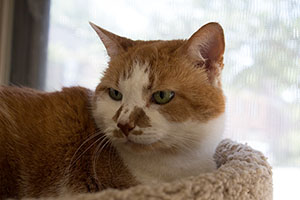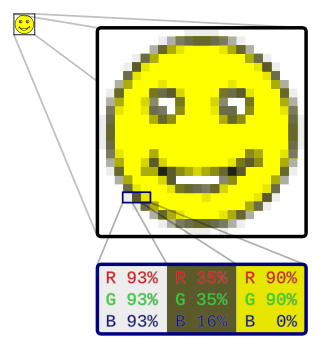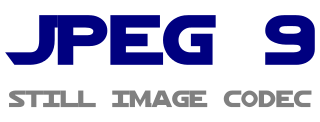Related Research Articles

JPEG is a commonly used method of lossy compression for digital images, particularly for those images produced by digital photography. The degree of compression can be adjusted, allowing a selectable tradeoff between storage size and image quality. JPEG typically achieves 10:1 compression with little perceptible loss in image quality. Since its introduction in 1992, JPEG has been the most widely used image compression standard in the world, and the most widely used digital image format, with several billion JPEG images produced every day as of 2015.

In information technology, lossy compression or irreversible compression is the class of data compression methods that uses inexact approximations and partial data discarding to represent the content. These techniques are used to reduce data size for storing, handling, and transmitting content. The different versions of the photo of the cat on this page show how higher degrees of approximation create coarser images as more details are removed. This is opposed to lossless data compression which does not degrade the data. The amount of data reduction possible using lossy compression is much higher than using lossless techniques.

In computer graphics and digital photography, a raster graphics represents a two-dimensional picture as a rectangular matrix or grid of square pixels, viewable via a computer display, paper, or other display medium. A raster is technically characterized by the width and height of the image in pixels and by the number of bits per pixel. Raster images are stored in image files with varying dissemination, production, generation, and acquisition formats.

JPEG 2000 (JP2) is an image compression standard and coding system. It was developed from 1997 to 2000 by a Joint Photographic Experts Group committee chaired by Touradj Ebrahimi, with the intention of superseding their original JPEG standard, which is based on a discrete cosine transform (DCT), with a newly designed, wavelet-based method. The standardized filename extension is .jp2 for ISO/IEC 15444-1 conforming files and .jpx for the extended part-2 specifications, published as ISO/IEC 15444-2. The registered MIME types are defined in RFC 3745. For ISO/IEC 15444-1 it is image/jp2.
The JPEG File Interchange Format (JFIF) is an image file format standard published as ITU-T Recommendation T.871 and ISO/IEC 10918-5. It defines supplementary specifications for the container format that contains the image data encoded with the JPEG algorithm. The base specifications for a JPEG container format are defined in Annex B of the JPEG standard, known as JPEG Interchange Format (JIF). JFIF builds over JIF to solve some of JIF's limitations, including unnecessary complexity, component sample registration, resolution, aspect ratio, and color space. Because JFIF is not the original JPG standard, one might expect another MIME type. However, it is still registered as "image/jpeg".
Tag Image File Format or Tagged Image File Format, commonly known by the abbreviations TIFF or TIF, is an image file format for storing raster graphics images, popular among graphic artists, the publishing industry, and photographers. TIFF is widely supported by scanning, faxing, word processing, optical character recognition, image manipulation, desktop publishing, and page-layout applications. The format was created by the Aldus Corporation for use in desktop publishing. It published the latest version 6.0 in 1992, subsequently updated with an Adobe Systems copyright after the latter acquired Aldus in 1994. Several Aldus or Adobe technical notes have been published with minor extensions to the format, and several specifications have been based on TIFF 6.0, including TIFF/EP, TIFF/IT, TIFF-F and TIFF-FX.

A compression artifact is a noticeable distortion of media caused by the application of lossy compression. Lossy data compression involves discarding some of the media's data so that it becomes small enough to be stored within the desired disk space or transmitted (streamed) within the available bandwidth. If the compressor cannot store enough data in the compressed version, the result is a loss of quality, or introduction of artifacts. The compression algorithm may not be intelligent enough to discriminate between distortions of little subjective importance and those objectionable to the user.

The Joint Photographic Experts Group (JPEG) is the joint committee between ISO/IEC JTC 1/SC 29 and ITU-T Study Group 16 that created and maintains the JPEG, JPEG 2000, JPEG XR, JPEG XT, JPEG XS, JPEG XL, and related digital image standards. It also has the responsibility for maintenance of the JBIG and JBIG2 standards that were developed by the former Joint Bi-level Image Experts Group.
DjVu is a computer file format designed primarily to store scanned documents, especially those containing a combination of text, line drawings, indexed color images, and photographs. It uses technologies such as image layer separation of text and background/images, progressive loading, arithmetic coding, and lossy compression for bitonal (monochrome) images. This allows high-quality, readable images to be stored in a minimum of space, so that they can be made available on the web.

libjpeg is a free library with functions for handling the JPEG image data format. It implements a JPEG codec alongside various utilities for handling JPEG data. It is written in C and distributed as free software together with its source code under the terms of a custom permissive (BSD-like) free software license, which demands attribution. The original variant is maintained and published by the Independent JPEG Group (IJG). Meanwhile, there are several forks with additional features.
JBIG is an early lossless image compression standard from the Joint Bi-level Image Experts Group, standardized as ISO/IEC standard 11544 and as ITU-T recommendation T.82 in March 1993. It is widely implemented in fax machines. Now that the newer bi-level image compression standard JBIG2 has been released, JBIG is also known as JBIG1. JBIG was designed for compression of binary images, particularly for faxes, but can also be used on other images. In most situations JBIG offers between a 20% and 50% increase in compression efficiency over Fax Group 4 compression, and in some situations, it offers a 30-fold improvement.
H.262 or MPEG-2 Part 2 is a video coding format standardised and jointly maintained by ITU-T Study Group 16 Video Coding Experts Group (VCEG) and ISO/IEC Moving Picture Experts Group (MPEG), and developed with the involvement of many companies. It is the second part of the ISO/IEC MPEG-2 standard. The ITU-T Recommendation H.262 and ISO/IEC 13818-2 documents are identical.
An image file format is a file format for a digital image. There are many formats that can be used, such as JPEG, PNG, and GIF. Most formats up until 2022 were for storing 2D images, not 3D ones. The data stored in an image file format may be compressed or uncompressed. If the data is compressed, it may be done so using lossy compression or lossless compression. For graphic design applications, vector formats are often used. Some image file formats support transparency.
JBIG2 is an image compression standard for bi-level images, developed by the Joint Bi-level Image Experts Group. It is suitable for both lossless and lossy compression. According to a press release from the Group, in its lossless mode JBIG2 typically generates files 3–5 times smaller than Fax Group 4 and 2–4 times smaller than JBIG, the previous bi-level compression standard released by the Group. JBIG2 was published in 2000 as the international standard ITU T.88, and in 2001 as ISO/IEC 14492.
JPEG XR is an image compression standard for continuous tone photographic images, based on the HD Photo specifications that Microsoft originally developed and patented. It supports both lossy and lossless compression, and is the preferred image format for Ecma-388 Open XML Paper Specification documents.

LuraTech is a software company, owned since 2015 by Foxit Software, with offices in Remscheid, Berlin, London, and in the United States, which makes products for handling and conversion of digital documents. Its customers are primarily organizations involved in long-term document archiving and scan service providers. It is a member of the PDF Association.
The ISO base media file format (ISOBMFF) is a container file format that defines a general structure for files that contain time-based multimedia data such as video and audio. It is standardized in ISO/IEC 14496-12, a.k.a. MPEG-4 Part 12, and was formerly also published as ISO/IEC 15444-12, a.k.a. JPEG 2000 Part 12.
JPEG XT is an image compression standard which specifies backward-compatible extensions of the base JPEG standard.
JPEG XS is an interoperable, visually lossless, low-latency and lightweight image and video coding system used in professional applications. Applications of the standard include streaming high quality content for virtual reality, drones, autonomous vehicles using cameras, gaming, and broadcasting. In this respect, JPEG XS is unique, being the first ISO codec ever designed for this specific purpose. JPEG XS, built on core technology from both intoPIX and Fraunhofer IIS, is formally standardized as ISO/IEC 21122 by the Joint Photographic Experts Group with the first edition published in 2019. Although not official, the XS acronym was chosen to highlight the eXtra Small and eXtra Speed characteristics of the codec. Today, the JPEG committee is still actively working on further improvements to XS, with the second edition scheduled for publication and initial efforts being launched towards a third edition.
References
- ↑ de Queiroz, Ricardo L.; Buckley, Robert R.; Xu, Ming (28 December 1998). Mixed Raster Content (MRC) Model for Compound Image Compression (PDF). Visual Communications and Image Processing '99. SPIE Proceedings. Vol. 3653. doi:10.1117/12.334618. ISBN 978-0-8194-3124-0 . Retrieved 2023-11-23.
- 1 2 "The MRC (Mixed Raster Content) Model and DjVu". PlanetDjVu. 10 June 2003.
- ↑ "Text Formats". Visioneer OneTouch Scanning Guide (PDF). October 2019. p. 33.
- ↑ "Image Compression". Kofax. Retrieved 11 March 2021.
- ↑ "Scanning and Compression White Paper" (PDF). Xerox. 2013. Archived from the original (PDF) on 2022-01-21.